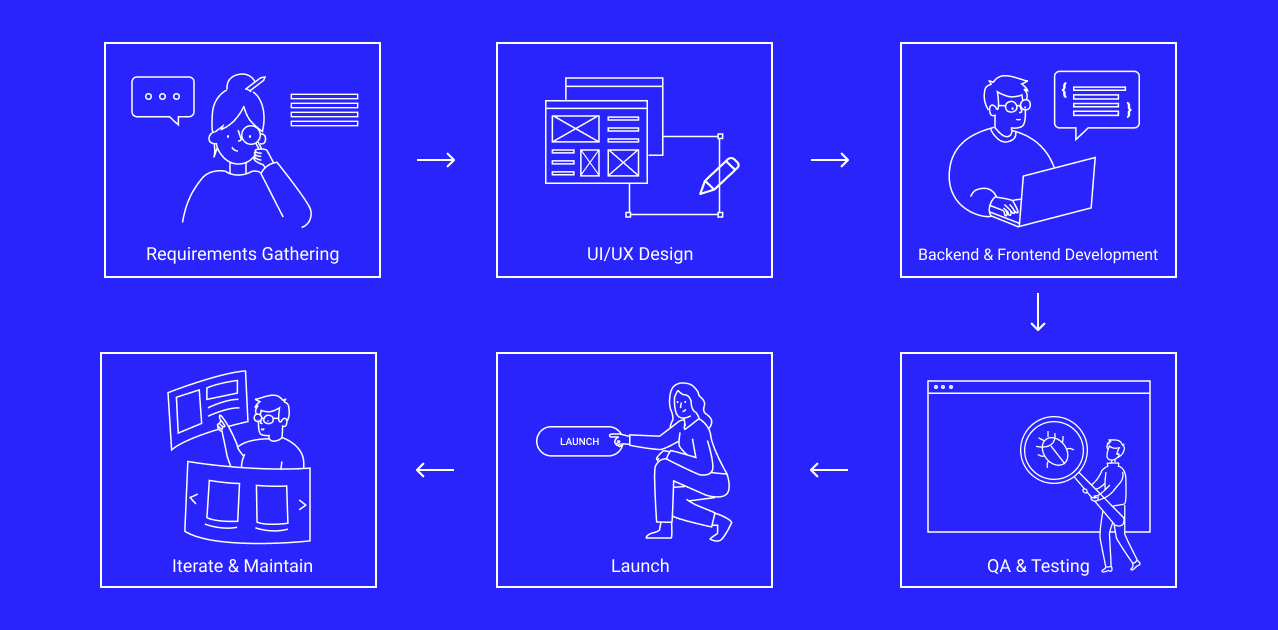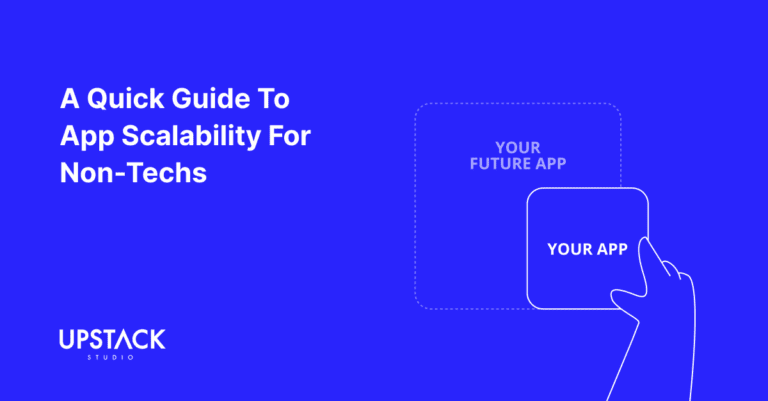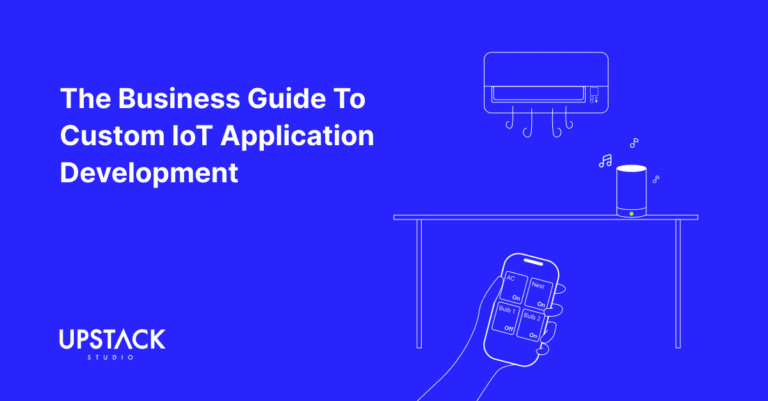In this post, I’m going to share how to estimate the amount of time it takes to build an app.
I’ll first cover the factors to consider when planning the timeline for an app development project.
Then I’ll break down the process that we use here at Upstack Studio.
This tried and tested framework has been refined over the past four years and has proven to deliver reliable timelines for our clients.
And now you’re going to see how it’s done, step by step.
Let’s dive right in.
What Affects The Time Needed to Make an App
Before we talk about the framework, let us first establish the two main factors that will influence your timeline.
Keep them in mind throughout the planning process and return to them whenever you’re unsure of a decision.
1. Scope
The scope of an app is made up of two main things:
- the app’s targeted platforms (e.g., Android, iOS or Web)
- the list of required features. It details what the app aims to achieve.
One of the first questions I ask our clients is which platform(s) they intend to launch their app’s first version on.
This is because each platform requires a different level of effort to build and the more platforms you want to support, the more time will be needed for design and development.
After figuring that out, we face the bigger challenge of scoping the features—what will the app be able to do?
From our experience at Upstack Studio, the typical situation is that too many features are requested for the first version of the app, also known as the Minimum Viable Product (MVP).
This is discouraged because apps in their early stages tend to fare better when they are lean and focused.
A long list of features means a wider scope, and this unnecessarily lengthens the development timeline and increases costs.
Our advice?
Cut out as much as you can upfront and keep your scope tight by including only platforms and features that will help you find your product-market fit.
The rest you can add in later versions.
2. Skills and Expertise
Another factor you need to consider is the skills and expertise you have access to.
The following are the skill sets your team would need to effectively build your app:
- UI Design
- UX Design
- Backend Development
- API Development
- Frontend Development (Web)
- Frontend Development (Mobile App)

An app development team that has all these skills should be able to build your app better and faster than a team with only some of them.
We once worked on a project where the client told us that their app was 90% completed and that they were just looking for extra help to improve the app’s overall functionality and stability.
However, we found out later that a huge portion of the app wasn’t even functioning.
It turned out that the app was built by a developer who had no prior experience in building mobile applications.
Despite this major setback, we managed to release a stable first version of the app within a month. This is because our team had all the right skill sets.
The lesson our client learned here was that although it might seem like a good idea to cut back on costs at the start, you’ll probably find that you would have to spend more time and money further down the line.
These precious resources could be spent instead on selling and marketing your product.
Of course, that doesn’t mean you have to splurge either.
How We Budget Time For App Development
Now with the two established factors in mind, let’s break down the framework we use to estimate mobile app development and web development project timelines at Upstack Studio.
There are six main stages in the mobile app development and web development cycle, each with its own timeline:
- Requirements Gathering
- UI/UX Design
- Backend and Frontend Development
- QA & Testing
- Launch
- Iterate & Maintain

In the following section, I’ll be detailing how much time you would usually need for each stage.
Stage #0: Prepare Your App Brief
Estimated Time: less than 1 week
When done right, this preliminary stage will help in making the following stages go more smoothly.
Come up with an App Brief so that your app development team can better understand your project.
Here are a few items you could include in your app brief:
- Problem
- Solution
- High-level Requirements
- Budget Range
- Timeline
- Similar Applications/Competitors
Stage #1: Requirements Gathering
Estimated Time: 1 – 2 weeks
During this phase, define and gather the requirements for your app.
If you’re not familiar with how to do this, speak to your app developer and sign up for their Product Roadmapping Workshop if they run one.
This should also help you differentiate the must-have features from nice-to-have ones.
The goal here is to prioritise the essential features for version one while making sure the app corresponds to business goals.
Attending a Product Roadmapping Workshop should provide you with a product backlog with user stories defined for all your gathered requirements.
Once we have the product roadmap, we move on to app design.
Stage #2: UI/UX Design
Estimated Time: 4 – 6 weeks
The UI/UX designer is the main person involved at this stage and works to ensure that the flow of the app provides a good User Experience (UX) while looking good (UI).
Good design is extremely important for any app to flourish in the market so consider putting more time and thought into this.
Stage #3: Backend and Frontend Development
Estimated Time: 12 – 18 weeks
Here, we have the backend developers build the back-end architecture which includes the app server, the database and the API while the frontend developers turn the designs created by the UI/UX team into actual app interfaces.
This usually takes up the most time in the product development cycle.
Stage #4: QA & Testing
Estimated Time: 2 – 4 weeks
To know whether the app is working as it should be, we do test runs.
Always remember that there’s no such thing as a bug-free app.
The main purpose of this phase is for us to improve the stability of the app while minimising bugs that will impact the user experience.
Make sure you allocate sufficient time to run alpha and beta testing to catch and fix as many bugs as possible before launching the app.
Stage #5: Launching Your App
Estimated Time: 1 – 2 weeks
Be sure to also allocate time for this phase too as apps are required to be submitted for review on the App Store and Play Store before they can be published.
Most companies do not take this into account and end up missing their launch date.
Pro-tip: Submit your app for review to Apple App Store, Google Play Store and Huawei AppGallery at least 1 – 2 weeks before your launch date.
Stage #6: Iterate & Maintain
Estimated Time: Indefinite
After launching, you’ll need to continue working with your developers to incorporate user feedback, fix bugs and keep the app updated overall.
Conclusion
Based on the average time ranges provided for each stage above, it should take you 4-6 months to build the first version of your app.
Remember that the time required to build an app varies, so it’s also possible for the timeline to be out of the range we provided.
However, we recommend keeping the app development timeline within six months or you might be over-building your app.
There are many factors and other considerations to keep in mind but the framework provided in this post should be enough to get you started.
As you get familiar with the process and encounter new problems, you can build upon this to cater to your use cases.
Got any further questions about estimating app development timelines?
Let me know in the comments below.





